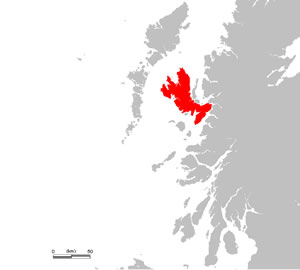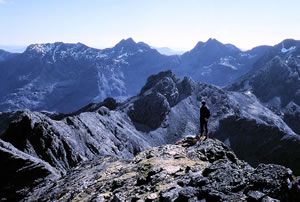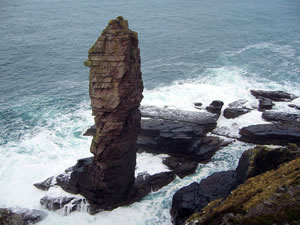The Isle of Skye is the largest island of the Inner Hebrides, a group of islands off the West Coast of Scotland.
Skye is located off the northwestern coat of Scotland.
It is separated from the Scottish mainland by the narrow strait of Loch Alsh.
The island's coastline is almost 1,600 km (1,000 mi) long. Its great length is due to its convoluted shape - the coastline contains dozens of rugged peninsulas
 Most of the island is surrounded by steep hills and solitary promontories.
Most of the island is surrounded by steep hills and solitary promontories.
At Dunvegan Head in the northwest, a sheer cliff rises 313m (1,028ft) from the waves until it forms a rounded, grassy summit.
The rugged backbone of the Black Cuillin Hills dominates the view from almost every vantage point on the island.
Twenty peaks feature in the Black Cuillins. 15 of them are more than 914m (3,000ft) in height. The tallest, Sgurr Alasdair, stand 1,009m (3,309ft) high.
 The Black Cuillins came into existence 50 million years ago when vast amounts of lava poured out of vents in the Earth's crust.
The Black Cuillins came into existence 50 million years ago when vast amounts of lava poured out of vents in the Earth's crust.
The hills are composed of gabbro, a hard rock derived from volcanic material that cooled slowly underground. Subterranean activity thrust them upward where their brittle substance was fashioned by the power of glaciers.
The Red Cuillin Hills, some 16km (10mi) to the east are composed of granite. This is the same volcanic material as gabbro, but it is softer because it cooled rapidly above ground.
The granite slopes of The Red Cuillins have a pink tinge. They are more rounded than the Black Cuillins, which resemble shards of broken crockery
In the north of the island stand the unusual cliffs and ravines of the Quiraing.
 Around 19km (12mi) to the south a rocky pinnacle, 50m (165ft) tall which is known as the Old Man of Storr, points skyward.
Around 19km (12mi) to the south a rocky pinnacle, 50m (165ft) tall which is known as the Old Man of Storr, points skyward.
Both these formations had their beginnings 10,000 years ago when the ice age glaciers retreated and left behind hard basalt rocks perched on soft clay slopes. As the clay collapsed and shifted, the basalt rocks slipped or were stranded in curious positions.
The numerous lochs around the island are another ice age legacy.
Valleys gouged out by glaciers were filled by seawater once the ice fields had retreated.
Many of the lochs, such as Loch Coruisk at the foot of the Black Cuillin Hills, open like fjords to the sea.
Life on the Isle of Skye
Crops can only grow in areas of Skye where the volcanic rock is covered by limestone, clay or sandstone.
Large flocks of sheep roam the moors and grasslands.
Despite the patchy fertility of its soil, the plant life on Skye is relatively abundant and includes many different varieties of flowering plants, ferns, liverworts and lichens.
Rare species of flowering plant include the red broomrape and Iceland purslane.
Heather can be found covering the moors.
Thousands of seabirds, including the arctic tern and the great skua, nest on the island's ragged coast and shore.
Puffins nest on high cliffs.
The golden eagle, which is about 80cm (32 in) long, can be found around the highest cliffs and peaks, especially the Black Cuillin Hills. It hunts hares, rabbits and grouse.